X
HGG Community Forums
Log In to HorseGeneticsGame
HGG Community Forums
Join our discord server!
Howdy, Stranger!
It looks like you're new here. If you want to get involved, click one of these buttons!
Categories
- All Discussions61,361
- Announcements1,188
- HAJ Discussion59,018
- ↳ New Member Introductions68
- ↳ Help Me Out5,084
- ↳ Horses for Sale and Auction14,457
- ↳ Breeding Ads and Sales6,078
- ↳ Herd Helpers22,965
- ↳ Bug Discussion6
- Non HAJ Discussion1,155
- ↳ Saddle Sisterhood113
- ↳ Games, Contests and GiveAWays348
- ↳ Genetics305
In this Discussion
- bkpatterson3 September 2016
- SandyCreekAcres September 2016
Who's Online (3)
- annismyrph 4:21PM
- Cavalynn 4:22PM
- Fiddler 4:21PM
Quick Guide
-
I know absolute NOTHING about genetics can anyone give like a quick cheat sheet of the basics? I don't even know the what common terms are or what they mean. Sorry if this is a stupid question.
-
It isn't a stupid question at all. Horse color genetics are incredibly complex, and not yet completely located and/or confirmed. You can check out the link to the Genetics Guide at the bottom of the left menu bar for more information, about specific genes, but I will give you a genetics primer, which I hope won't be too basic for you.
Genes are found on chromosomes in the nucleus of cells. Mammals all have a double set of chromosomes, one set inherited from their father and the other from their mother. So, for every gene that influences the color of a horse's coat, it has two copies, one copy from the sire and one from the dam.
When a mare and a stallion are bred together, the foal will receive one of the two copies of each gene that the stallion has and one of the two copies of each gene that the mare has. Which copy the foal receives from each parent is totally random.
A common tool for figuring out which gene pairs a foal might receive is a grid called a Punnet Square. Here is an example of one.
It deals with the inheritance of one of the mutations of the Kit gene that causes white spotting, and shows the chances of getting a dead foal if two horses with white spotting Kit mutations are crossed.
The sire's two copies of the Kit gene are found in the top row. The dam's copies of the Kit gene are found in the left column. Each copy is in its own row or column.
Then the sire's gene copy on the left is matched with each of the mare's copies where the second column and the second and third rows cross. The same thing is done with the sire's gene copy on the left.
This gives four possible matches of genes from this sire and dam. You can see that two of them are the same, and two are different from any of the others.
I have to work on serving supper, so I will return and give you a quick list of the color genes that are found in the game (and, in many cases, in real life).Post edited by SandyCreekAcres at 2016-09-23 19:03:39
-
Genetics Primer, Part 2
Each gene has a dominant form, usually signified by a capital letter, and a recessive form, signified by a lower case letter. For many genes, having one dominant copy will cause that gene to influence coat color or pattern. Some genes have to have the same copy of the gene to affect the coat color or pattern. This usually happens when it is the recessive form of the gene that causes the effect.
When both copies of a gene are the dominant form or both are the recessive form, the gene is called homozygous--meaning both copies are the same. If one copy is the dominant form and the other is the recessive form, the gene is called heterozygous--meaning the copies are different.
The technical term for a variation of a gene is "allele," so we would speak of the dominant allele and the recessive allele.
Now we get to specific color genes, and things get really interesting and sometimes quite complicated. Don't expect to master all this with one reading. Note that in the game, when you color test a horse, the genes which are affecting its color and pattern will be reported, but if the horse doesn't carry the color affecting allele of a gene will probably no show up.
Two genes are the primary determiners of a horse's coat color.
The first is called Extension and is identifed by E for the dominant allele and e for the recessive allele. E is a complete dominant, which means that a singe copy of the dominant allele will color the horse's hair black. A horse with two recessive extension alleles, "ee", will have a red coat (chestnut).
The second primary color determiner is called Agouti, and is identified by the letter A for the dominant allele and a for the recessive allele. What this gene does is to push any black pigment into the "points" of the horse--the mane and tail and the lower legs.
If the horse has even one dominant allele of Agouti and homozygous or heterozygous dominant E, this displacement of the black pigment will occur and the horse will be a Bay.
If the horse has any dominant alleles of Agouti and homozygous recessive e, the horse will still be chestnut, but it can pass on the dominant Agouti to its offspring So if a foal gets a dominant E from its other parent, it will be a bay.
In order for a horse to be black, it has to be at least heterozygous for dominant E and homozygous for recessive Agouti.
So, the primary variations in coat color are:
EE AA--homozygous dominant for both genes= a Bay horse.
Ee AA, Ee Aa, EE Aa, Ee, Aa will all produce a Bay horse.
ee AA, ee Aa, ee aa will all produce a Chestnut horse
EE aa, Ee aa will produce a black horse.

-
Genetics Primer, Part 3
However, Agouti has two other possible alleles which have different levels of dominance and cause different effects in coat color. Remember that a horse has to have at least heterozygous E for Agouti to affect its color.
A+, Wild Bay, is the most dominant of the Agouti allele. A single copy of Wild Bay will override all the other three alleles of this gene. The effect of Wild Bay is chiefly shown in the game by diluting the black pigment in the legs, and usually making it patchy. Here is an example of a horse with Wild Bay.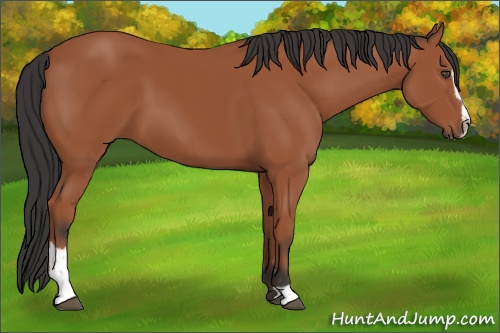
http://www.huntandjump.com/horse.php?horseid=3092289
A, normal Dominant Agouti, is the second most dominant of the Agouti alleles. It will be hidden by Wild Bay, but overrides the other two alleles. Here is an example of a Bay horse.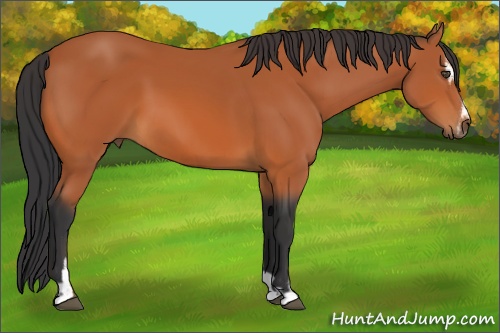
http://www.huntandjump.com/horse.php?horseid=2520583
At, Brown, is recessive to both Wild Bay and normal dominant Agouti. It will only affect coat color if it is paired with the recessive allele of Agouti. Ata. Paired with the Sooty gene (which I will say more about later) it makes the horse's coat appear very dark brown, almost black, especially along the neck. Here are some examples of Brown horses.
Ata, no Sooty, no Pangare (which lightens hair along the belly an on the muzzle).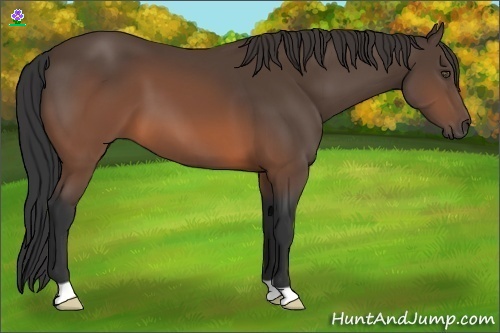
http://www.huntandjump.com/horse.php?horseid=3199601
Ata, heterozygous Sooty and Pangare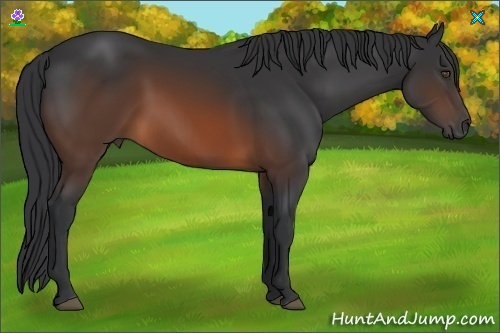
http://www.huntandjump.com/horse.php?horseid=2855010
Ata, homozygous Sooty, heterozygous Pangare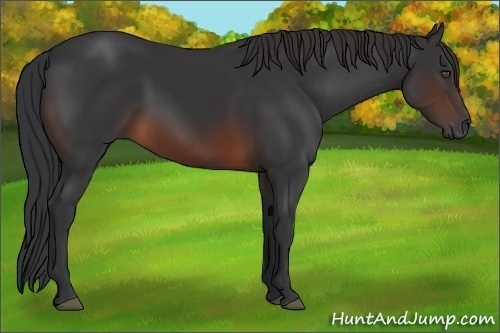
http://www.huntandjump.com/horse.php?horseid=2872552
a, recessive Agouti, is overridden by all the other Agouti alleles. A horse that is homozygous recessive Agouti, aa, will be chestnut if it has homozygous recessive Extension, ee, or black if it has one or two copies of dominant Extension, EE or Ee.
-
Genetic Primer Part 4
Sooty and Dilution Genes
Sooty is a gene that causes black hairs to appear on a horse from the top down, as if a bucket of soot had been dumped over it. The absence of this mutation is written S, its presence is written Ssty,
Homozygous Sooty will have more effect than heterozygous Sooty. This characteristic is called incomplete dominance. If you compare the brown horses above, you can spot the difference between homozygous recessive Sooty, heterozygous Sooty, and homozygous Sooty.
Black horses can carry Sooty, but it will not show because their coat is already completely black.
There are 4 dilution genes that cause different amount of lightening of the coat color. They may also have other effects, depending on the gene and whether or not is is homozygous or heterozygous. Cream is an incomplete dominant gene, which means that there is a distinct difference in the affects when it is heterozygous or homozygous. The other three dilution genes, Dun, Silver, and Champagne are complete dominant genes. They have the same effect whether they are heterozygous or homozygous.
Cream has three alleles. C, no mutation; Ccr, considerable lightening of the coat; Cprl, less lightening of the coat, and must be homozygous to affect coat color. However when combined with the Ccr allele, Cprl will cause additional lightening to the coat. This combination of alleles is called "pseudo-double dilute."
Cream primarily dilutes red colored coats (chestnuts and bays). It has to be homozygous to have an easily seen effect on black coats.
Homozygous Ccr causes extreme lightening of the coat and blue eyes.
Chestnut plus Ccr creates Palomino horses. Chestnut plus CcrCcr creates Cremello horses.
Palomino, note that the mane and tale are lighter in color.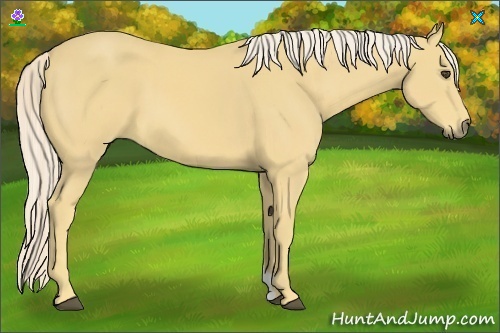
http://www.huntandjump.com/horse.php?horseid=2765353
Cremello, note the eye color; the skin is pink.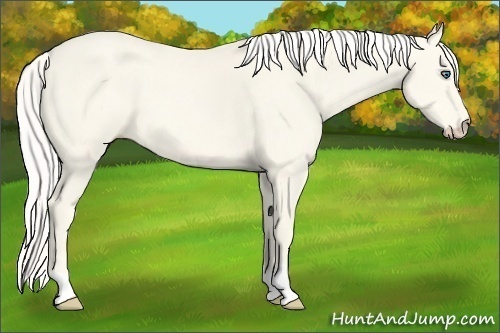
http://www.huntandjump.com/horse.php?horseid=2867287
Bay plus Ccr creates Buckskin horses. Bay plus CcrCcr creates Perlino horses.
Buckskin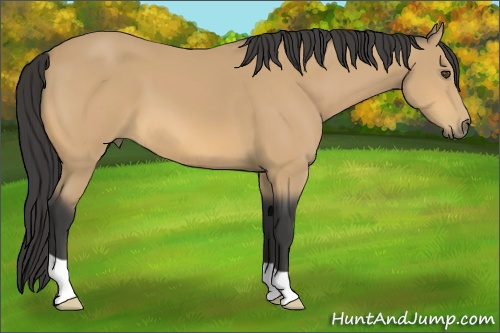
http://www.huntandjump.com/horse.php?horseid=2709741
Perlino--note dilution of mane and tail, blue eyes, and pink skin
http://www.huntandjump.com/horse.php?horseid=2748293
Black plus Ccr creates Smokey Cream horses that appear to be black. Black plus CcrCcr creates Smokey Creme horses that have diluted coats.
Smokey Black--note that any dilution of the coat color is scarcely visible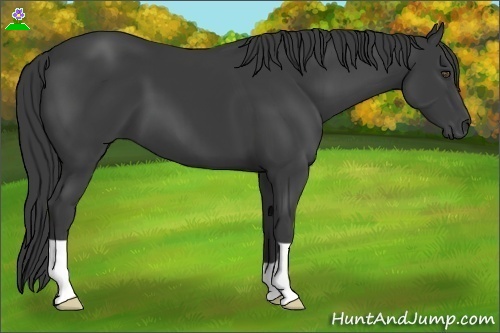
http://www.huntandjump.com/horse.php?horseid=2829677
Smokey Creme--note that the dilution of the coat is not as extreme as with Cremellos and Perlinos, but the eyes are blue and the skin pink here as well.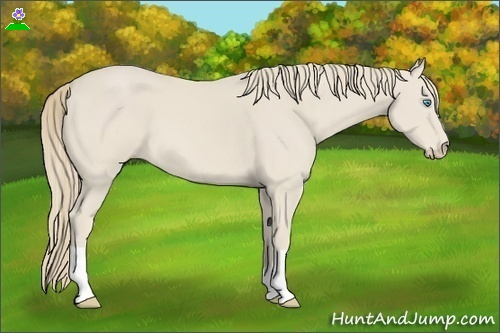
http://www.huntandjump.com/horse.php?horseid=3351658

-
I will come back tomorrow, I hope and continue, if you want me to.

-
Wow! I had no idea it was so complex!! I might need a degree in genetics for this game. I will be coming back to this post very often to figure out more stuff. Personally I like the appys, paints, and bays myself so I am going to try and learn what I will need to make my barn full of appys, paints, and bays! Thank you SandyCreek Acres for all the help!Thanked by 1SandyCreekAcres
-
Remember that there are many variations in the colors, some caused by genes, other caused by the dynamic image generator. Just as in real life, there are shades and shades of most of the colors.
I'll try to tackled the rest of the color dilution genes tonight and will address the pattern genes, which are full of complexity, especially with the Kit gene and Appaloosa. This will help you understand the basics of how the varieties of Paint appearances come about.
A lot of the complexity is caused by the sheer number of genes that are involved in determining a horse's color and pattern.
If you do a search for all the Bay horses in the game, you will get a sample of the variations in color just for that basic category caused by all the many dilution and pattern genes that can affect it.
As for the degree in genetics, just learning what this game makes possible will almost qualify you for a basic degree, although it won't quite give all the scientific information involved. Ammit does provide some of the scientific chromosome and gene names in her genetics guide, though.Post edited by SandyCreekAcres at 2016-09-24 14:32:40















